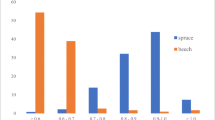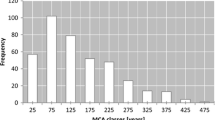Abstract
We present a functional regression model for diameter prediction. Usually stem form is estimated from a regression model using dbh and height of the sample tree as predictor. With our model additional diameter observations measured at arbitrary locations within the sample tree can be incorporated in the estimation in order to calibrate a standard prediction based on dbh and height. For this purpose, the stem form of a sample tree is modelled as a smooth random function. The observed diameters are assumed as independent realizations from a sample of possible trajectories of the stem contour. The population average of the stem form within a given dbh and height class is estimated with the taper curves applied in the national forest inventory in Germany. Tree deviation from the population average is modelled with the help of a Karhunen–Loève expansion for the random part of the trajectory. Eigenfunctions and scores of the Karhunen–Loève expansion are estimated through conditional expectations within the methodological framework of functional principal component analysis (FPCA). In addition to a calibrated estimation of the stem form, FPCA provides asymptotic pointwise or simultaneous confidence intervals for the calibrated diameter predictions. For the application of functional principal component analysis modelling the covariance function of the random process is crucial. The main features of the functional regression model are discussed informally and demonstrated by means of practical examples.






Similar content being viewed by others
References
Cressie N (1991) Statistics for spatial data. Probability and mathematical statistics. Wiley, New York, 900 pp
Dierckx P (1993) Curve and surface fitting with splines. Monographs on numerical analysis. Oxford Science Publications. Clarendon Press, Oxford, pp 285
Gregoire TG, Schabenberger O, Kong F (2000) Prediction from an integrated regression equation: a forestry application. Biometrics 56:414–419. doi:10.1111/j.0006-341X.2000.00414.x
Hradetzky J (1980) Spline Funktionen und ihre Anwendung in der forstlichen Forschung. Forstwissenschaftliches Centralblatt 100(1):45–59. doi:10.1007/BF02640618
Kublin E (2003) Einheitliche Beschreibung der Schaftform—Methoden und Programme—BDATPro. Forstw Cbl 122(3):183–200. doi:10.1046/j.1439-0337.2003.00183.x
Lappi J (2006) A multivariate, nonparametric stem-curve prediction method. Can J For Res 36(4):1017–1027. doi:10.1139/X05-305
Mardia KV, Kent JT, Bibby JM (1979) Multivariate analysis. Academic Press, London
Max TA, Burkhart HE (1976) Segmented polynomial regression applied to taper equations. For Sci 22(3):283–289
Pollanschütz J (1965) Eine neue Methode der Formzahl- und Massenbestimmung stehender Stämme. (Neue Form- bzw. Kubierungsfunktion und ihre Anwendung). Dissertation Thesis, Hochschule für Bodenkultur Wien, Wien: Forstliche Bundesversuchsanstalt, pp 168
Rojo A, Perales X, Sanchez-Rodriguez F, Alvarez-Gonzalez JG, v Gadow K (2005) Stem taper functions for maritime pine (Pinus pinaster Ait.) in Galicia (Northwestern Spain). Eur J For Res 124(3):177–186. doi:10.1007/s10342-005-0066-6
Sloboda B, Gaffrey D, Matsumura N (1998) Presentation of tree individual taper curves and their dynamics by spline functions and generalization by linear taper curve models. Allg Forst Jagdzeitung 169(2):29–39
Trincado G, Burkhart HE (2006) A generalized approach for modeling and localizing stem profile curves. For Sci 52(6):670–682
Wood SN (2006) Generalized additive models: an introduction with R. Texts in Statistical Science Series, 67. Chapman & Hall, CRC, pp 416
Yao F, Muller HG, Wang JL (2005) Functional data analysis for sparse longitudinal data. J Am Stat Assoc 100(470):577–590. doi:10.1198/016214504000001745
Zhang YJ, Borders BE, Bailey RL (2002) Derivation, fitting, and implication of a compatible stem taper-volume-weight system for intensively managed, fast growing loblolly pine. For Sci 48(3):595–607
Author information
Authors and Affiliations
Corresponding author
Additional information
Communicated by M. Köhl.
Rights and permissions
About this article
Cite this article
Kublin, E., Augustin, N.H. & Lappi, J. A flexible regression model for diameter prediction. Eur J Forest Res 127, 415–428 (2008). https://doi.org/10.1007/s10342-008-0225-7
Received:
Revised:
Accepted:
Published:
Issue Date:
DOI: https://doi.org/10.1007/s10342-008-0225-7




